Nuclear paxillin functions as a molecular switch for alternative splicing in neurons during a critical period of brain development
Dr. Cheng, Pei-Lin - September, 2025
During a critical period of postnatal brain development, neural circuits undergo significant refinement coincident with widespread alternative splicing of hundreds of genes, which undergo altered splice site selection for the generation of isoforms essential for synaptic plasticity. Here, we reveal that neuronal activity-dependent phosphorylation of paxillin at its serine 119 (p-paxillinS119) acts as a molecular switch in the nucleus for the control of alternative splicing during this period. We show that following NMDA receptor activation, nuclear p-paxillinS119 is recruited to nuclear speckles, where it interacts with splicing factors, such as U2AFs. Neuronal paxillin expression is required for timely alternative splicing of synaptic factors, including Snap25. Young mice lacking paxillin S119 phosphorylation exhibit significantly reduced levels of Snap25-5b isoforms, impaired presynaptic function at hippocampal Schaffer collateral-CA1 synapses, and deficits in short-term learning and memory. These findings support the idea that nuclear p-paxillinS119 is a critical mediator of alternative splicing programs in postnatal neurons that are essential for neural plasticity during a critical period of brain development.
